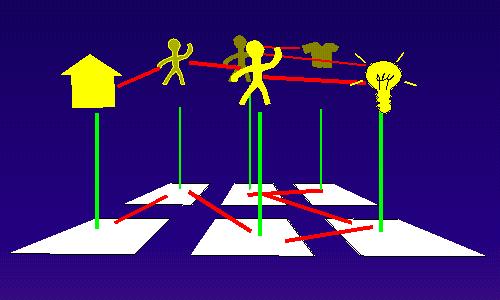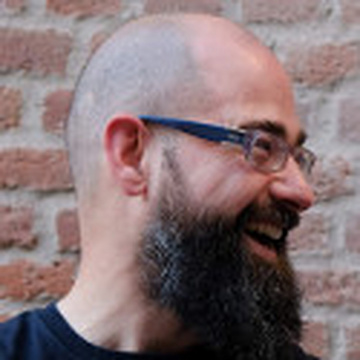Stop e leggere: Sir Tim parla del Giant Global Graph - step 1
Ultimamente ho parlato parecchio di Social Graph, di Social Network e di valore aggiunto di ritorno che dobbiamo avere dalle reti sociali che usiamo… [ Facebook compresa ]…
Ora il grande Tim Berners Lee ( inventore del Web per antonomasia ) fa una sintesi da leggere tutta d’un fiato, ne faro’ una traduzione a breve, assolutamente fondamentale e poco tecnica, ma con metafore imperdibili..
Fonti ulteriori
[ in aggiunta al post di tim, ho inserito due immagini che completano alcune idee, tratte da queste fonti:
-> Shadows on the Web
-> From Net to Graph ]
Partiamo quindi da una lettura a flusso di coscienza, veloce ma che metta a fuoco alcuni concetti…
The Net we normally use as short for Internet […] The realization of the Net was, “It isn’t the cables, it is the computers which are interesting”. The Net was designed to allow the computers to be seen without having
to see the cables.[…]
The word Web we normally use as short for World Wide Web. The WWW increases the power we have as users again.
The realization was “It isn’t the computers, but the documents which are interesting“. Now you could browse around a sea of documents without having to worry about which computer they were stored on.[…]
The Net links computers, the Web links documents. […]
Ho sintetizzato il flusso di coscienza su alcuni punti: questo e’ il passaggio chiave, che potrebbe racchiudere il tanto decantato Web2.0, in linea di **maggiore consapevolezza nei medesimi strumenti loosed coupled **.)
Now, people are making another mental move. There is realization now, “It’s not the documents, it is the things they are about which are important“. Obvious, really.
Spero tutto questo risulti abbastanza chiaro: se aggiungiamo a tutto questo la consapevolezza che il sistema non comprende molte cose a cui noi teniamo, e che invece magari potrebbero essere automatiche, alleggerendo le nostre stanche spalle…
The separate Web sites, separate documents, are in fact about the same thing – but the system doesn’t know it.
Questo e’ quello che in due parole, si vuole fare con il Semantic Web, come chi legge i miei post da tempo, dovrebbe aver capito.
Tim fa, poi, un passaggio ulteriore:
Its not the Social Network Sites that are interesting – it is the Social Network itself. The Social Graph. The way I am connected, not the way my Web pages are connected.
Quindi per permettere un riutilizzo creativo di tale livello sociale, come prima con la connessione tra computers, e poi tra documenti, occorre salire di livello…
Si parla sempre di livello di astrazione sui concetti e sulle cose che stiamo usando quotidianamente…
So, if only we could express these relationships, such as my social graph, in a way that is above the level of documents, then we would get re-use. That’s just what the graph does for us.
Un caso che RDF sia proprio un modello basato su un grafo? .)
Al di la’ dei tecnicismi, questo e’ in sintesi quello che dobbiamo pretendere:
People running Internet systems had to let their computer be used for forwarding other people’s packets, and connecting new applications they had no control over. People making web sites sometimes tried to legally prevent others from linking into the site, as they wanted complete control of the user experience, and they would not link out as they did not want people to escape. Until after a few months they realized how the web works. And the re-use kicked in. And the payoff started blowing people’s minds.
Letting your data connect to other people’s data is a bit about letting go in that sense. It is still not about giving to people data which they don’t have a right to. It is about letting it be connected to data from peer sites. It is about letting it be joined to data from other applications.
Questo effetto si avrebbe seguendo tale metodologia:
If a social network site uses a common format for expressing that I know Dan Brickley, then any other site or program (when access is allowed) can use that information to give me a better service. Un-manacled to specific documents.
Non e’ solo tecnologia, che tra l’altro in parte e’ stata completata…
Ci vuole un cambio di mentalita’…
In the long term vision, thinking in terms of the graph rather than the web is critical to us making best use of the mobile web, the zoo of wildy differing devices which will give us access to the system.
Bisogna ripensare il Web dalle sue fondamenta, dal fatto che quell’indirizzo che scriviamo e che inizia per HTTP, racchiude alcune idee, tanto semplici quanto fondamentali: una RISORSA che ha una LOCAZIONE e ha un TIPO.
Proviamo a svuotare la mente in merito.
Ma su questo ci torno su un post futuro…
Step 1…


